In this article, you will learn about What is Reaction Turbine? and How It Works? Its Parts, Types, Advantages, and Applications are explained.
You can also download PDF file of this article at the end.
What is a Reaction Turbine?
Reaction turbines are a type of turbine that develops torque by reacting to the gas or fluid’s pressure or mass. The operation of reaction turbines is described by Newton’s third law of motion (action and reaction are equal and opposite).
In a reaction turbine, the water enters the wheel under pressure and flows over the vanes, As the water, flowing over the vanes is under pressure. Therefore, the wheel of the turbine runs full and may be submerged below the tailrace or may discharge into the atmosphere.
While flowing over the vanes, the pressure head of water is converted into a velocity head and is finally reduced to the atmospheric pressure before leaving the wheel.
Read Also: Definition of Fluid: Types of Fluids in Fluid Mechanics
Parts of Reaction Turbine
Following are the main parts of reaction turbine:
- Spiral casing
- Guide mechanism
- Turbine runner
- Draft tube
#1 Spiral Casing
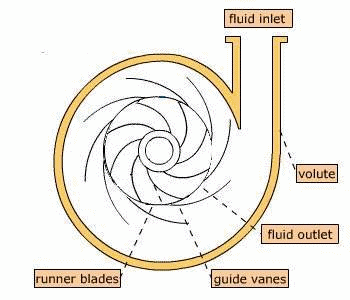
The water from a pipeline is distributed around the guide’s ring in a casing. This casing is designed so that its cross-sectional area goes on, reducing uniformly around the circumference.
The cross-sectional area is maximum at the entrance and the minimum at the tip as shown in Fig. As a result, the casing will be of the spiral casing or scroll casing.
#2 Guide Mechanism
The guide vanes are fixed between two rings in the form of a wheel. This wheel is fixed in the spiral casing. The guide vanes are properly designed to:
- To allow the water to enter the runner without shock.
- Allow the water to flow over them without forming eddies.
- Allow the required quantity of water to enter the turbine. (this is done by adjusting the opening of the vanes).
All the guide vanes can rotate about their respective pivots, which are connected to the regulating ring by some mechanical means. The regulating ring is connected to the regulating shaft using two regulating rods.
The guide vanes may be closed or opened by rotating the regulating shaft, Thus allowing the required quantity of water to flow according to the need. The regulating shaft is operated using a governor, whose function is to govern the turbine (i.e., to keep the speed constant at varying loads). The guide vanes are generally made of cast steel.
Read Also: Different Types of Metals and Their Properties [PDF]
#3 Turbine Runner
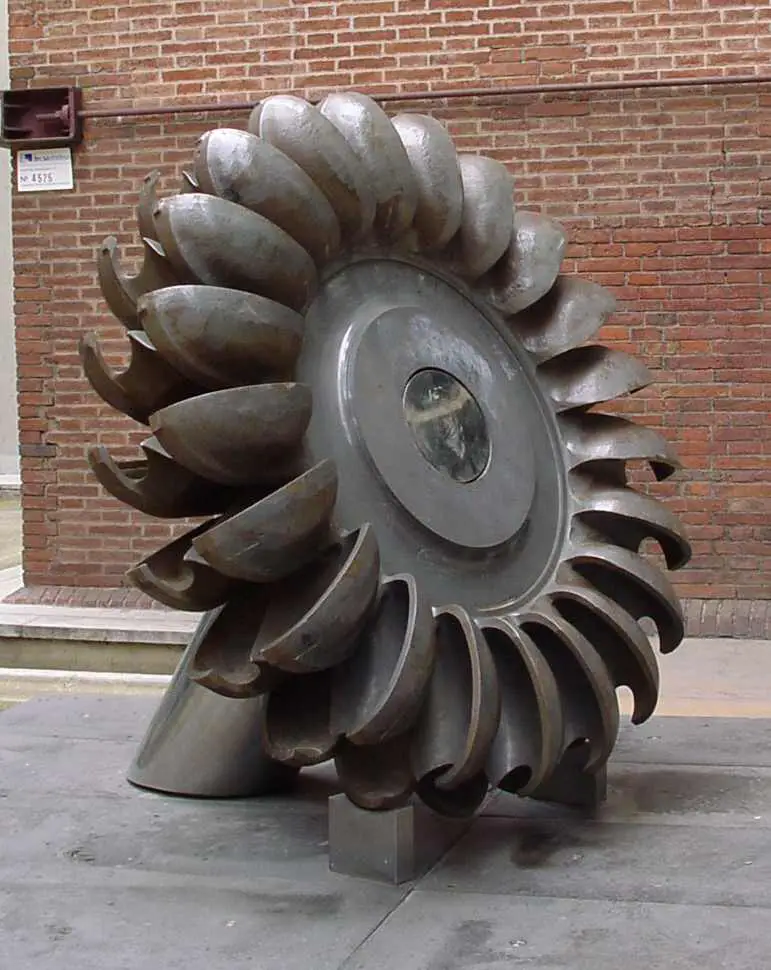
The runner of a reaction turbine consists of runner blades fixed either to a shaft or rings, depending upon the type of turbine. The blades are correctly designed to allow the water to enter and leave the runner without shock.
The runner is keyed to a shaft, which may be vertical or horizontal. If the shaft is vertical, it is called a vertical turbine. Similarly, if the shaft is horizontal, it is called a horizontal turbine.
The surface of the runner is made very smooth. The runner may be cast in one piece it may be made of separate steel plates and welded together. For low heads, the runner may be cast iron. But for high heads, the runner is made of steel or alloys. When the water is chemically impure, the runner is made of a special alloy.
#4 Draft Tube
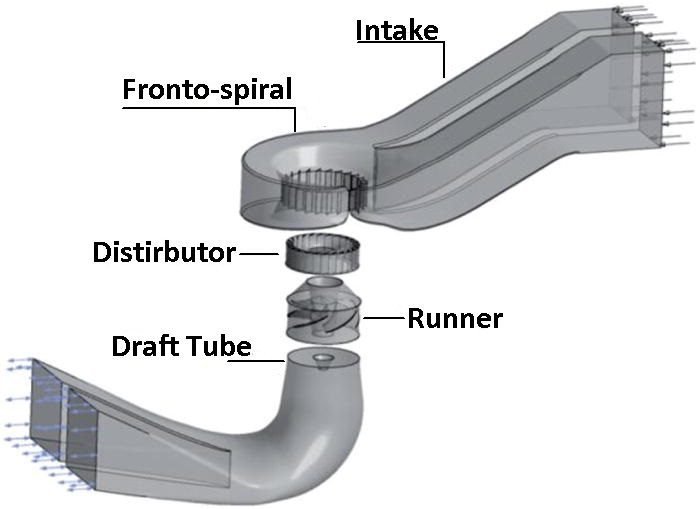
The water, after passing through the runner, flows down through a tube called a draft tube. It is, generally, drowned approximately 1 m below the tailrace level. A draft tube has the following functions:
- It increases the head of water by an amount equal to the height of the runner outlet above the tailrace;
- It increases the efficiency of the turbine.
Read also: What is Impulse Turbines: How it works
Working of Reaction Turbine
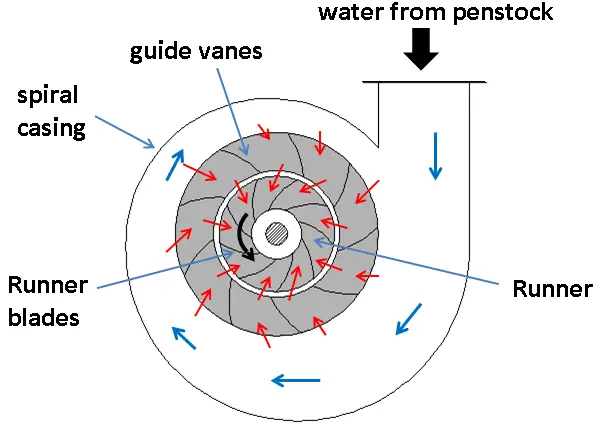
Initially, the water is supplied through the penstock from the reservoir to the turbine. Water enters the cover, which is surrounded by a runner. The casing has several fixed vanes. It partially turns the available head into a dynamic head with water.
As the cross-sectional area of the casing gradually decreases, it maintains a constant velocity of water throughout the turbine runner. With the help of the vane, the water flows through the runner with minimal energy loss.
When water hits the rotating vane, it applies an impulse force due to the kinetic energy of the water. As water flows over the rotating vane, it creates a pressure difference on the vane. This is due to the airfoil shape of the vane, which causes the water to exert a lift force over the vane.
This lifting force rotates the runner. Water flows through the draft tube from the runner, providing the suction head at the runner exit. Finally, the exhaust water goes into the tailrace, which is further used in various applications.
Read Also: Centrifugal Pump: Diagram, Parts, Working, Advantages [PDF]
Types of Reaction Turbine
The reaction turbines may be classified into the following three types, depending upon the direction of the flow of water through the wheel.
Types of Reaction Turbine are:
- Radial flow turbines.
- Axial flow turbines.
- Mixed flow turbines.
Radial Flow Turbines
In such turbines, the flow of water is radial (i.e., along with the wheel’s radius). The radial flow turbines may be further sub-division into the following two classes:
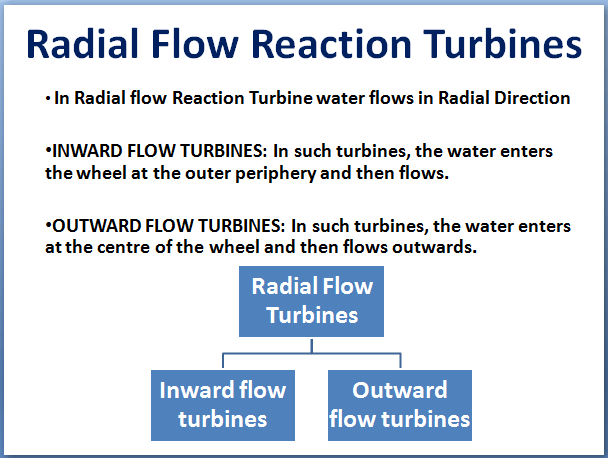
Inward Flow Turbines
- In such turbines, the fluid enters the wheel at the outer periphery, and then the fluid flows inwards (i.e., towards the center of the wheel).
- Here the runner is surrounded by a guide mechanism.
- In this turbine, the outer diameter of the runner is the inlet, and the inner diameter is the outlet.
Outward Flow Turbines
- In such turbines, the water enters at the center of the wheel and then flows outwards (i.e., towards the outer periphery of the wheel).
- Here guide mechanism is surrounded by the runner.
- In this turbine, the inner diameter of the runner is the inlet, and the outer diameter is an outlet.
Axial Flow Turbines
In such turbines, the water flows parallel to the axial of the wheel. Such turbines are also called parallel flow turbines.
Types of Reaction Turbine in Axial Flow Turbine:
- Kaplan turbine
- Propeller turbines
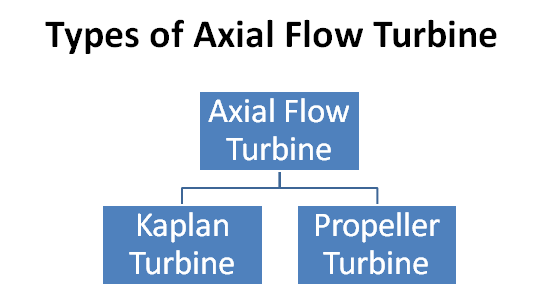
Kaplan Turbine
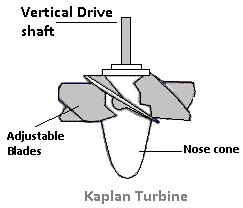
The Kaplan turbine is a propeller-type water turbine that has adjustable blades. It was developed in 1913 by the Austrian professor Viktor Kaplan.
The Kaplan turbine was an evolution of the Francis turbine. Its invention allowed efficient power production in low-head applications that were impossible with the Francis turbine. Kaplan turbine is now widely used worldwide in high-flow, low-head power production.
Propeller Turbine
The propeller turbine is a type of inward-flow reaction turbine that is found in both ships and submarines. It has a propeller-like runner with movable or fixed blades.
Water flow in the propeller turbine is controlled by changing adjustable guiding vanes, sometimes referred to as wicket gates. By guiding the water toward the runner, these vanes help the water’s energy be transferred to the blades.
This is often used in areas with strong hydraulic conditions, which are typified by high water flow rates.
Mixed Flow Turbines
These are the latest type of turbines, in which the flow is partly radial and partly axial.
Types of Reaction Turbines in Mixed Flow Turbines: Francis turbine, gravity turbine, bulb turbine, and kinetic turbine.
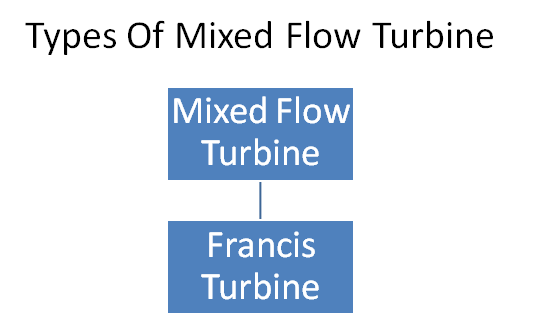
Francis Turbine
The Francis turbine is a type of reaction turbine that was developed by James B. Francis. It is an inward-flow reaction turbine that combines radial and axial flow concepts.
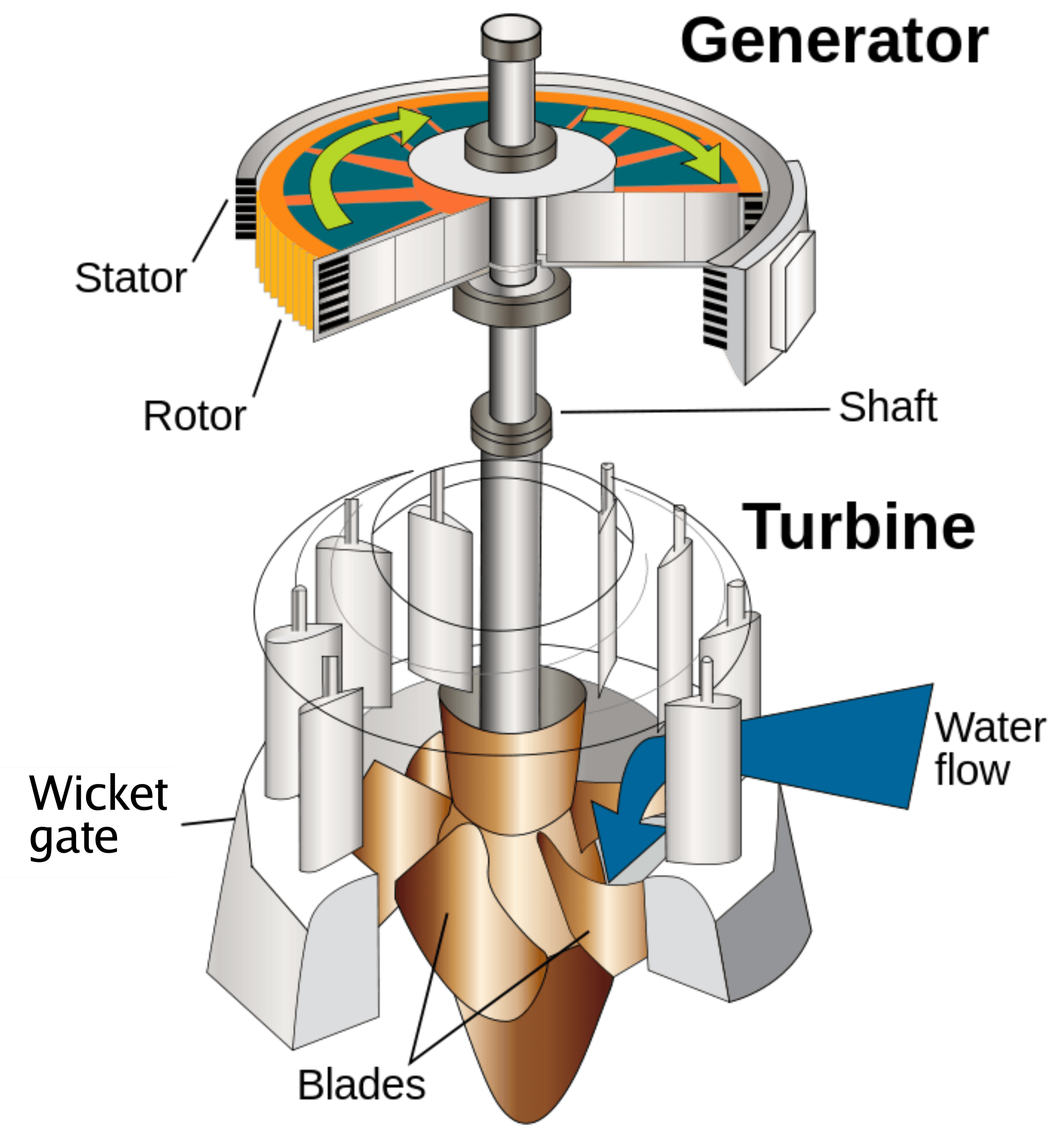
They operate in a head range of ten meters to several hundred meters and are primarily used for electrical power production, and their output varies from a few kilowatts to 1000 megawatts.
In this turbine, the working fluid changes pressure as it moves through the turbine, giving up its energy. These turbines are located between the high-pressure water source and the low-pressure water exit.
Gravity Turbine
Using gravity as a source of energy, a gravity turbine, also known as an undershot water wheel, generates electricity.
The way this kind of turbine works is that it places its wheel—which is usually fitted with buckets or blades—at the bottom of a water source, like a river or stream.
In the past, gravity turbines were used for various applications, including grinding grain, sawing wood, and operating small machines.
Bulb Turbine
A bulb turbine is a compact and unique hydropower turbine design. It combines the turbine and generator parts into a single unit that has the shape of a bulb.
This turbine works by harnessing the energy of flowing water to create power, and it is usually placed right in a water channel, such as a river or canal.
Kinetic Turbine
The basic concept of a kinetic turbine is to transform a high-velocity fluid jet’s kinetic energy into mechanical energy. This kind of turbine is made to capture the energy of water that is flowing freely, usually at a low flow rate and high head.
Read Also: Different Types of Pumps and Their Uses [Explained]
Advantages of Reaction Turbine
- Reaction turbine generally has high hydraulic efficiency.
- These types of turbines require less space.
- This pump design is simple and easy to build.
- They can operate at high temperatures and high pressure.
- The blades of a reaction turbine have higher efficiency compared to an impulse turbine.
Disadvantages of Reaction Turbine
- These turbines require a higher maintenance cost.
- In some cases, the turbine faces a cavity problem.
- Since the blades of this turbine are not symmetrical, this is also a drawback.
- A reaction turbine produces a high thrust force.
Applications of Reaction Turbine
Reaction turbines are commonly used to generate electricity in wind power mills. It is a widely used turbine because it receives maximum output power from low-access water heads and high velocities. In addition, it is also for generating electricity in hydropower plants.
Closing It Up
That’s it, thanks for reading. If you like the article on “Reaction turbines and types of reaction turbines” please share it with your friends. If you have any questions, leave a comment.
Want interesting articles direct to your inbox? Then subscribe to our newsletter.
Download the PDF of this article
Read more in our blog:
- Types of Washers & How They Use?
- 12 Different Types of Fasteners and Their Uses
- Different Types of Screws & Their Uses
FAQs
Reaction turbines are those that rotate by capturing both the pressure and the velocity of the flowing water.
In an impulse turbine, there is a pressure drop across the fixed blades only, whereas in a reaction turbine, there is a pressure drop across both fixed and moving blades.
Reaction turbines have been known for being very efficient, adaptable to different water flow rates, and suitable for low- to medium-head applications.
The Pelton turbine is referred to as an impulse turbine, in contrast to other turbine designs that are reaction turbines. This means that water generates an impulsive force on the turbine to cause it to move, rather than the turbine moving due to a reaction force.
Very nice article..
Thank you 🙂
This article is best for a student taking this course for the first time, it really simplify the terminologies and give clear analysis… Thanks for putting this together, how I wish you could make more articles to further explain the formula derivation and solved examples…
reaction turbine is quite confusing part. but here in this article it is explained in the detailed and in very simple language. kindly provide the pdf of the article at the end of your article. thank you
You’re welcome:) and thanks for your comment, now you can download PDF file of this post.
this is reallly usefull